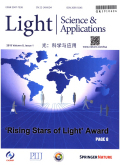- 钛学术文献服务平台 \
- 学术期刊 \
- 工业技术期刊 \
- 电工技术期刊 \
- 光:科学与应用(英文版)期刊 \
Dual-resonance enhanced quantum light-matter interactions in deterministically coupled quantumdot- micropillars
Dual-resonance enhanced quantum light-matter interactions in deterministically coupled quantumdot- micropillars
基本信息来源于合作网站,原文需代理用户跳转至来源网站获取
摘要:
Optical microcavities have widely been employed to enhance either the optical excitation or the photon emission processes for boosting light-matter interactions at the nanoscale. When both the excitation and emission processes are simultaneously facilitated by the optical resonances provided by the microcavities, as referred to the dual- resonance condition in this article, the performances of many nanophotonic devices approach to the optima. In this work, we present versatile accessing of dual-resonance conditions in deterministically coupled quantum-dot (QD)-micropillars, which enables emission from neutral exciton (X)—charged exciton (CX) transition with improved single-photon purity. In addition, the rarely observed up-converted single-photon emission process is achieved under dual-resonance conditions. We further exploit the vectorial nature of the high-order cavity modes to significantly improve the excitation efficiency under the dual-resonance condition. The dual-resonance enhanced light-matter interactions in the quantum regime provide a viable path for developing integrated quantum photonic devices based on cavity quantum electrodynamics (QED) effect, e.g., highly efficient quantum light sources and quantum logical gates.

推荐文章
Oil geochemistry derived from the Qinjiatun–Qikeshu oilfields: insight from light hydrocarbons
Light hydrocarbons
Crude oil
Lishu Fault Depression
Geochemistry characteristic
Geochemical tracing and modeling of surface and deep water-rock interactions in elementary granitic
Weathering
Water pathways
U activity ratios
Sr isotope ratios
Anthropogenic gases (CFC,SF6)
CZO
The contribution of bacteria to organic matter in coal-measure source rocks
Coal-measure source rocks
Organic matter type
Bacteria
Monomethyl alkanes
Alkyl cyclohexane
Determination of brominated diphenyl ethers in atmospheric particulate matter using selective pressu
Brominated diphenyl ethers
Atmospheric particulate matters
Selective pressurised liquid extraction
Gas chromatography-mass spectrometry
内容分析
关键词云
关键词热度
相关文献总数
(/次)
(/年)
文献信息
| 篇名 | Dual-resonance enhanced quantum light-matter interactions in deterministically coupled quantumdot- micropillars | ||
| 来源期刊 | 光:科学与应用(英文版) | 学科 | |
| 关键词 | |||
| 年,卷(期) | 2021,(9) | 所属期刊栏目 | Articles |
| 研究方向 | 页码范围 | 1680-1686 | |
| 页数 | 7页 | 分类号 | |
| 字数 | 语种 | 英文 | |
| DOI | |||
五维指标
引文网络
引文网络
二级参考文献 (0)
共引文献 (0)
参考文献 (0)
节点文献
引证文献 (0)
同被引文献 (0)
二级引证文献 (0)
2021(0)
- 参考文献(0)
- 二级参考文献(0)
- 引证文献(0)
- 二级引证文献(0)
引文网络交叉学科
相关学者/机构
期刊影响力
光:科学与应用(英文版)
主办单位:
中国科学院长春光学精密机械与物理研究所
出版周期:
双月刊
ISSN:
2095-5545
CN:
22-1404/O4
开本:
出版地:
吉林省长春市东南湖大路3888号
邮发代号:
创刊时间:
语种:
eng
出版文献量(篇)
762
总下载数(次)
0
期刊文献
相关文献
推荐文献
- 期刊分类
- 期刊(年)
- 期刊(期)
- 期刊推荐
一般工业技术
交通运输
军事科技
冶金工业
动力工程
化学工业
原子能技术
大学学报
建筑科学
无线电电子学与电信技术
机械与仪表工业
水利工程
环境科学与安全科学
电工技术
石油与天然气工业
矿业工程
自动化技术与计算机技术
航空航天
轻工业与手工业
金属学与金属工艺
光:科学与应用(英文版)2022
光:科学与应用(英文版)2021
光:科学与应用(英文版)2020
光:科学与应用(英文版)2019
光:科学与应用(英文版)2018
光:科学与应用(英文版)2017
光:科学与应用(英文版)2016
光:科学与应用(英文版)2021年第9期
光:科学与应用(英文版)2021年第8期
光:科学与应用(英文版)2021年第7期
光:科学与应用(英文版)2021年第6期
光:科学与应用(英文版)2021年第5期
光:科学与应用(英文版)2021年第4期
光:科学与应用(英文版)2021年第3期
光:科学与应用(英文版)2021年第2期
光:科学与应用(英文版)2021年第12期
光:科学与应用(英文版)2021年第11期
光:科学与应用(英文版)2021年第10期
光:科学与应用(英文版)2021年第1期

 免费查重
免费查重










